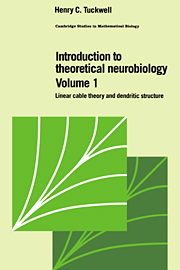Book contents
- Frontmatter
- Contents
- Preface
- 1 Introductory neuroanatomy and neurophysiology: the properties of motoneurons
- 2 The classical theory of membrane potentials
- 3 The Lapicque model of the nerve cell
- 4 Linear cable theory for nerve cylinders and dendritic trees: steady-state solutions
- 5 Time-dependent cable theory for nerve cylinders and dendritic trees
- 6 Rail's model neuron
- References
- Index
5 - Time-dependent cable theory for nerve cylinders and dendritic trees
Published online by Cambridge University Press: 29 December 2009
- Frontmatter
- Contents
- Preface
- 1 Introductory neuroanatomy and neurophysiology: the properties of motoneurons
- 2 The classical theory of membrane potentials
- 3 The Lapicque model of the nerve cell
- 4 Linear cable theory for nerve cylinders and dendritic trees: steady-state solutions
- 5 Time-dependent cable theory for nerve cylinders and dendritic trees
- 6 Rail's model neuron
- References
- Index
Summary
Introduction
In the preceding chapter we showed how, in the framework of cable theory, the steady-state depolarization could be found either in a nerve cylinder or a whole neuron composed of soma, dendritic tree, and axon. To achieve that, we had to solve ordinary differential equations with given boundary conditions at terminals and branch points.
The steady-state solutions are of interest when they can be related to experimental results and can provide some relatively quick insights into the effects of various input patterns and various neuronal geometries. In the natural activity of a nerve cell, however, steady-state conditions will never prevail. In order to understand the dynamic behavior of nerve cells, we must therefore examine the time-dependent solutions.
To obtain the time-dependent solutions, we must solve the partial differential equation (4.25), or the dimensionless version (4.59), for the depolarization V(x, t) at position x at time t. The inclusion of the time variable makes obtaining solutions more difficult, though it may be said that if we are using the linear cable model, there is no problem that we cannot, in principle, solve.
We will begin by showing the usefulness of the Green's function method of solution for nerve cylinders. This extends the approach we used in the previous chapter, and the technique can be used for any spatio–temporal input pattern. We will then look at the case of a nerve cylinder with time-dependent current injection at a terminal.
- Type
- Chapter
- Information
- Introduction to Theoretical Neurobiology , pp. 180 - 233Publisher: Cambridge University PressPrint publication year: 1988
- 1
- Cited by



